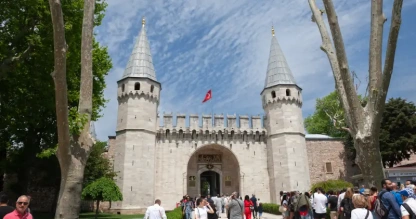
Discover the Ancient City of Ephesus
Ephesus, founded in the 10th century BC, emerged as the fourth largest city of its time after Rome, Alexandria, and Antioch. The city's population reached an impressive 250,000 inhabitants. Among the Seven Wonders of the Ancient World stood its magnificent Temple of Artemis, completed around 550 BC.
The ancient metropolis flourished in what is now western Turkey, thanks to its prime location at the intersection of major trade routes. A sheltered harbor in the Aegean Sea and proximity to prominent land trade routes fueled the settlement's prosperity. Visitors today can explore remarkable structures throughout Ephesus, Turkey, including the Library of Celsus and a grand theater that once accommodated 25,000 spectators.
Ephesus's legacy reaches far beyond its architectural splendor. The ancient city played a significant role in early Christianity's growth, as St. Paul launched numerous missionary trips from this location. The ruins gained international recognition in 2015 with their designation as a UNESCO World Heritage Site.
The Origins of Ephesus
Early settlements and Neolithic evidence
People lived in the area around Ephesus since the Neolithic Age, around 6000 BC. Excavations at the artificial mounds called höyük at Arvalya and Cukurici prove this. The oldest settlement in Ephesus dates back to 8200 BC, based on findings at Cukurici Höyük.
These settlers built a thriving farming community. They grew barley, wheat, lentils, flax, and figs, and raised domestic animals. The sea played a vital role in their lives too. Archeologists found fish bones, crab remains, and various molluscs at the site. The coastline sat 1.5-2 kilometers north of where these people lived.
The Bronze Age and the city of Apasa
Archeologists found early Bronze Age settlements at Ayasuluk Hill. Hittite records from the 14th century BC show the region's name as Apasa (or Abasa).
This city served as Western Anatolia's Arzawa kingdom's capital.
Scholars think Apasa and Ephesus refer to the same place. A Mycenaean burial ground near St. John's basilica ruins supports this theory. These graves date back to 1500-1400 BC, when the Ahhiyawa started settling in Asia Minor.

Ephesus Through the Ages
Ephesus endured many shifts in power across centuries. After surviving Cimmerian raids in the 7th century BCE, it fell under King Croesus of Lydia, who funded the Temple of Artemis. The Persians soon conquered Anatolia in 547 BCE, but Alexander the Great freed the city in 334 BCE. His general Lysimachus later relocated it and renamed it Arsineia.
Under Roman rule from 129 BCE, Ephesus thrived as the capital of Asia province. The 1st and 2nd centuries CE marked its golden age, when the Library of Celsus, the Great Theater (seating 24,000), and bustling bath complexes transformed it into one of the Mediterranean’s greatest cities.
Decline followed with Gothic invasions in 262 CE and the silting of its harbor. Still, it became a Christian center, hosting councils in 431 and 449 CE and seeing the rise of St. John’s Basilica. By Byzantine and later Ottoman times, Ephesus had dwindled to a small town, Ayasoluk—modern-day Selçuk.

Religious and Cultural Significance
The Temple of Artemis and pagan worship
Completed around 550 BCE, the Temple of Artemis was Ephesus’s most celebrated monument and one of the Seven Wonders of the Ancient World. The grand sanctuary measured 425 by 225 feet, supported by 127 marble columns, each 60 feet tall. Pilgrims, merchants, and rulers brought lavish offerings to honor “the Lady of Ephesus,” a unique form of Artemis blending Greek and Anatolian traditions.
The temple was first destroyed in 356 BCE by Herostratus, who sought eternal fame through arson. Rebuilt on an even greater scale—four times larger than the Parthenon—it remained a marvel until repeated attacks, with the Goths’ raid in 268 CE marking its final destruction.
Ephesus in early Christianity
Ephesus became an important center for early Christianity by the mid-1st century CE. The Apostle Paul lived in the city between 52–54 CE, preaching first in the synagogue before moving to the school of Tyrannus. His teachings against idol worship provoked opposition, most famously the riot led by silversmith Demetrius, who feared the decline of the Artemis cult.
The Council of Ephesus
In 431 CE, Emperor Theodosius II convened the Third Ecumenical Council in Ephesus’s Church of Mary. Around 250 bishops debated Nestorius’s teachings on Christ’s nature and Mary’s title. Cyril of Alexandria supported the title Theotokos (God-bearer), while Nestorius preferred Christotokos (Christ-bearer). The council affirmed Mary as Theotokos and condemned Nestorianism as heresy, leading to the Nestorian Schism.
The House of the Virgin Mary
Located about seven kilometers from Selçuk, the House of the Virgin Mary is believed by tradition to be where Mary lived before her assumption. Rediscovered in the 19th century following the visions of German nun Anne Catherine Emmerich, the site was later protected by Sister Marie de Mandat-Grancey.
While the Catholic Church has not confirmed its authenticity, several popes, including Paul VI, John Paul II, and Benedict XVI, have visited. Today, it remains a pilgrimage site for both Christians and Muslims, with visitors leaving prayers on the “wishing wall.”

Exploring the Ruins Today
A walk through Ephesus offers visitors an unmatched glimpse into ancient Roman urban life during their Turkey tour. The archeological site stands among the largest in the eastern Mediterranean. The well-preserved ruins still show the city's former splendor.
Library of Celsus
The iconic Library of Celsus remains Ephesus's most prominent landmark. Built around 125 CE to honor Tiberius Julius Celsus Polemaeanus, this magnificent structure housed nearly 12,000 scrolls. A sarcophagus beneath the library holds Celsus's remains.
The builders designed an exaggerated entrance to make the building look bigger. The facade came back to life between 1970 and 1978 when experts used original fragments. The east-facing design let reading rooms catch maximum morning light.

The Great Theater
The Great Theater sits on Panayir Mountain's slope and shows extraordinary ancient engineering. The Hellenistic period (3rd century BCE) saw its initial construction. The Romans expanded it later. This massive structure held about 25,000 spectators in 66 rows of seats. Three horizontal walkways split these rows into sections. The theater's amazing acoustics let people in the last row hear even whispers from the stage.

Terrace Houses and Roman baths
The luxurious Terrace Houses stand next to Curetes Street. People call these "Houses of the Rich". These grand homes spread across three terraces and showcase beautiful mosaics and well-preserved frescoes. Families lived here from the 1st through 7th centuries CE. Clay pipes under floors and behind walls created sophisticated heating systems. Visitors can now explore two fully restored houses that show how the Roman elite lived.

Temple of Hadrian and other landmarks
The Temple of Hadrian, built in 138 CE, ranks among Curetes Street's best-preserved buildings. Four Corinthian columns hold up a curved arch on its facade. A relief of Tyche, goddess of victory, adorns this arch. The interior friezes tell the city's founding story. They show Androklos shooting a boar and Dionysus's ceremonial processions. The city also boasted several major bath complexes. An advanced aqueduct system fed many water mills throughout Ephesus.

Visitor tips for Ephesus of Turkey
Smart planning makes an Ephesus visit better. The archeological site has no shelter, so summer visitors should come in the morning to beat the heat. You'll need comfortable shoes since no vehicles can enter. The surfaces range from steep paths to slippery marble. Most people see the main sites in 2-3 hours. The Terrace Houses need extra time and have a separate entrance fee. A licensed guide can share historical context and fascinating stories that bring the ruins to life.
Ephesus stands as remarkable proof of human civilization that spans thousands of years. This ancient metropolis evolved from a Neolithic settlement to become one of the Roman world's greatest cities. Today, it remains a rich source of archeological discoveries for visitors to explore.

FAQS
1. Where is the ancient city of Ephesus located?
Ephesus lies near the modern town of Selçuk in western Turkey, close to the Aegean coast.
2. Why is Ephesus historically important?
It was a major trade and cultural center of the ancient world, home to the Temple of Artemis, one of the Seven Wonders.
3. What are the main ruins to see in Ephesus?
Highlights include the Library of Celsus, the Great Theater, the Temple of Hadrian, and marble-paved streets.
4. What role did Ephesus play in Christianity?
Ephesus became an early Christian hub, linked to Paul the Apostle, John the Apostle, and the Council of Ephesus in 431 CE.
5. How can visitors reach Ephesus today?
The site is easily accessible from İzmir Airport, about an hour’s drive, with many guided tours departing from nearby Kusadasi.
Discover the best of Turkey on our Turkey tours and Middle East trips!














